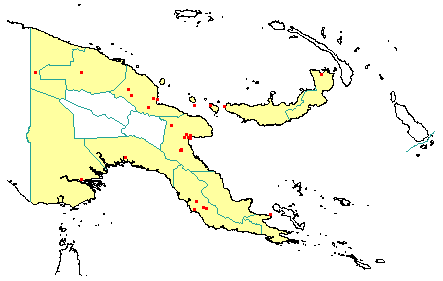
in PNGplants database
PNGTreesKey – Alstonia scholaris (L.) R.Br. |
Barry Conn (NSW) & Kipiro Damas (LAE).
Guide to trees of Papua New Guinea
Copyright held by the authors, National Herbarium of New South Wales, and Papua New Guinea National Herbarium
Memoirs of the Wernerian Natural History Society Vol. 1: 76 (1811)
Other Literature: D.J. Boyland et al., Forest Trees of Australia, 4th edn 78-79 (1984)
Family: Apocynaceae
Dicotyledon
Timber Group: Major exportable hardwood Tradename: White Cheesewood
Field Characters: Large canopy tree (up to c. 20 m high, rarely to 40 m); Bole cylindrical (usually flanged basally, 60-100 cm diam.); straight (bole 10-25 m long); buttresses buttresses present; spines spines absent; aerial roots aerial roots absent; stilt roots stilt roots absent; Bark cream-coloured, pale yellow, rarely grey, or rarely brown, slightly rough, fissured, pustular, or slightly tessellated, lenticels elongated laterally or sometimes lenticels elongated vertically; Subrhytidome (under-bark) yellow; less than 25 mm thick, 8.0-12.0; bark blaze consisting of one layer; strongly aromatic; resinous/linament-like or slightly spice-like; outer blaze white (yellowish cream-coloured) or yellowish brown, speckled, granular without splinters; inner blaze white (yellowish cream-coloured) or yellowish brown, speckled, granular without splinters; bark exudate (sap) present, white/milky, flowing, colour not changing on exposure to air, sticky; terminal buds not enclosed by leaves.
Indumentum: Complex hairs absent; stinging hairs absent; mature twig indumentum (hairs) absent.
Leaves: Leaves spaced along branches, whorled (with more than two leaves at one node of a branchlet), 4-8, simple (a leaf composed of a single blade); petiole present (1-1.5 cm long), not winged, attached to base of leaf blade, not swollen; leaves broadest above middle or broadest at or near middle, 7.5-15.5 cm, 3.0-5.0 cm; symmetric, entire, not dissected or lobed, obtuse, venation pinnate, secondary veins closed, not prominent, but visible, intramarginal veins present; leaves lower surface blue-green, upper surface dark green, indumentum (hairs) absent; absent; domatia absent; stipules absent.
Flowers: Inflorescence terminal or axillary (appearing in terminal in upper axils), flowers on a branched axis, cones absent; flowers bisexual (sweetly aromatic), stalked, flowers with many planes of symmetry, 10.0-12.0 mm long, diameter small (up to10 mm diam.); perianth present, with distinct sepals and petals whorls, inner perianth white (cream-coloured); 5, some or partly joined; stamens 5, present, free of each other, joined to the perianth; ovary superior, carpels joined (when more than one), locules 2; styles solitary, 1.
Fruits: Infrutescence arranged on branched axis, fruit 300.0 mm long, greenish yellow or green, not spiny, non-fleshy, simple (2 follicles), dehiscent, follicle; seeds 100, to about 5 mm long, not winged, narrow (longer than wide) (with tufts if long hairs), seed 1-10 mm diam.
Distribution: West Sepik, East Sepik, Madang, Morobe, Western, Gulf, Central, Northern, Milne Bay & New Britain.
 | Botanical records in PNGplants database |